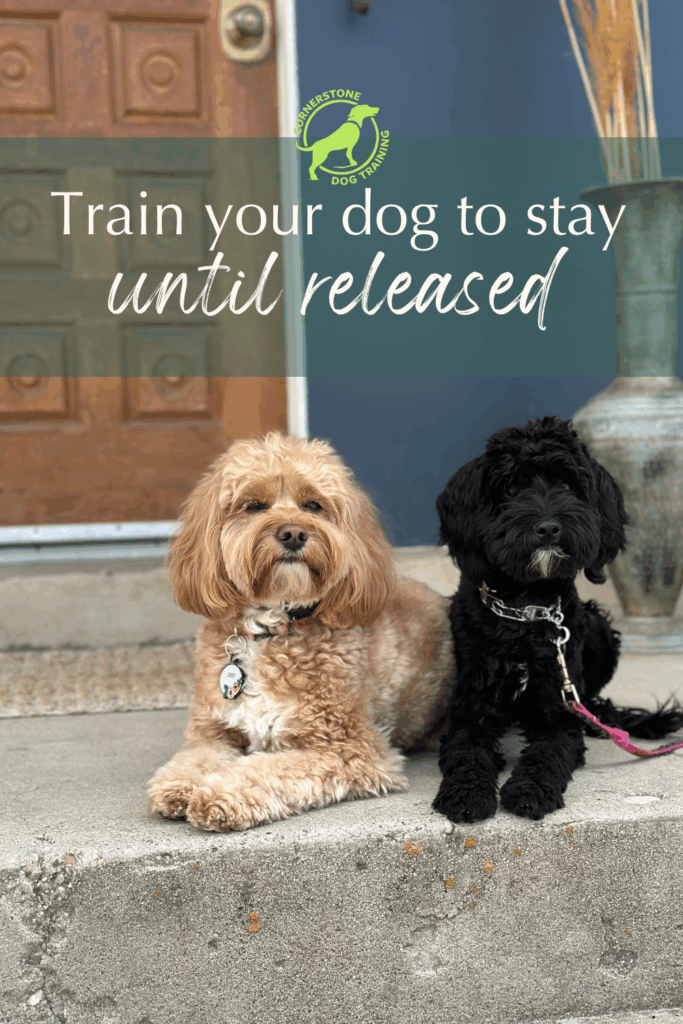Implied Stay: The Command That Changes Everything
Imagine telling your dog to “sit” and being able to walk away—without having to repeat yourself—while your dog patiently waits for you to return. No “stay” command, no constant reminders, no creeping forward inch by inch. Train your dog to stay until released. That’s the beauty of an implied stay.
At Cornerstone Dog Training, we use this skill to give dogs clear boundaries and owners more freedom. It’s one of the most functional commands you can teach, and it’s exactly how you train your dog to stay until released—every time.
Why an Implied Stay Works Better Than “Stay”
Most owners teach “stay” as a separate command, but in reality, every command should come with the expectation that your dog holds it until released.
- When you say “sit,” it means sit until I say otherwise. When you say “down,” it means down until I say otherwise
- The release word ends the command.
This keeps training clear and eliminates the “How long do I hold this?” guessing game for your dog. The implied stay is the foundation for how to train your dog to stay until released in any setting.
Step 1: Teach a Release Word
We use “Okay!”, but you can choose any consise word—just be consistent.
- Ask your dog to sit.
- Mark the sit with “Yes!” and reward.
- Once they’re sitting, make eye contact, then say your release word.
- Step back and encourage them to move toward you for a reward.
Pro tip: Always pair the release word with eye contact. That way, your dog won’t break a command just because they heard you say “okay” in conversation.
Step 2: Add Duration
Start small—just a few seconds of holding the command. Gradually build to longer periods. If your dog breaks before you release them:
- Calmly guide them back into position using the leash.
- Don’t reward when they return; the treat only comes when they stay until the release.
This repetition is key to train your dog to stay until released without constant reminders.
Step 3: Add Distance
Once your dog can hold the position for a short time, start taking steps away. Begin with one step, then return, make eye contact, and release. Slowly increase the number of steps over multiple sessions.
Step 4: Add Distractions
Life is full of temptations—doorbells, squirrels, kids running by. The implied stay teaches your dog to focus on you regardless of what’s happening. Introduce distractions gradually:
- Drop a toy nearby.
- Have a family member walk past.
- Practice near a doorway before going for a walk.
Each time, only release after they’ve ignored the distraction and made eye contact.
Just a Trick?
An implied stay isn’t just a party trick. It’s a tool for calmer, safer living:
- When guests arrive: No more lunging out, instead holding the down command.
- At mealtime: Wait calmly until released to eat.
- In public: Hold a down or place until released, even with distractions.
When you train your dog to stay until released, you simplify communication, build trust, and turn your dog into a focused partner rather than a constant management project.
Why it’s important to train your dog to stay until released:
With a consistent release word and the patience to build time, distance, and distractions, your dog will learn that every command comes with a built-in “stay.” It’s one of the most life-changing habits we teach in our Puppy and Chaos to Calm training programs—and it can transform daily life with your dog.

See the training principles in action!
This is great!